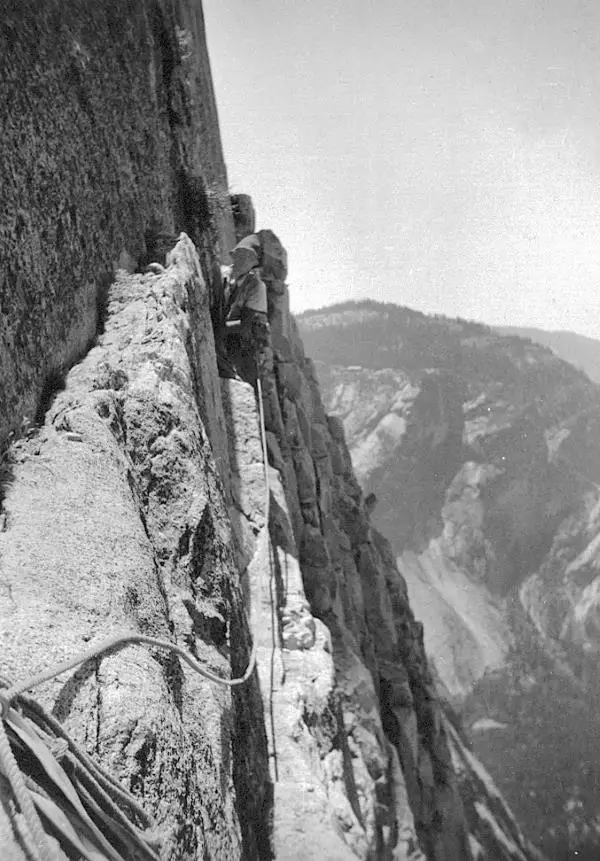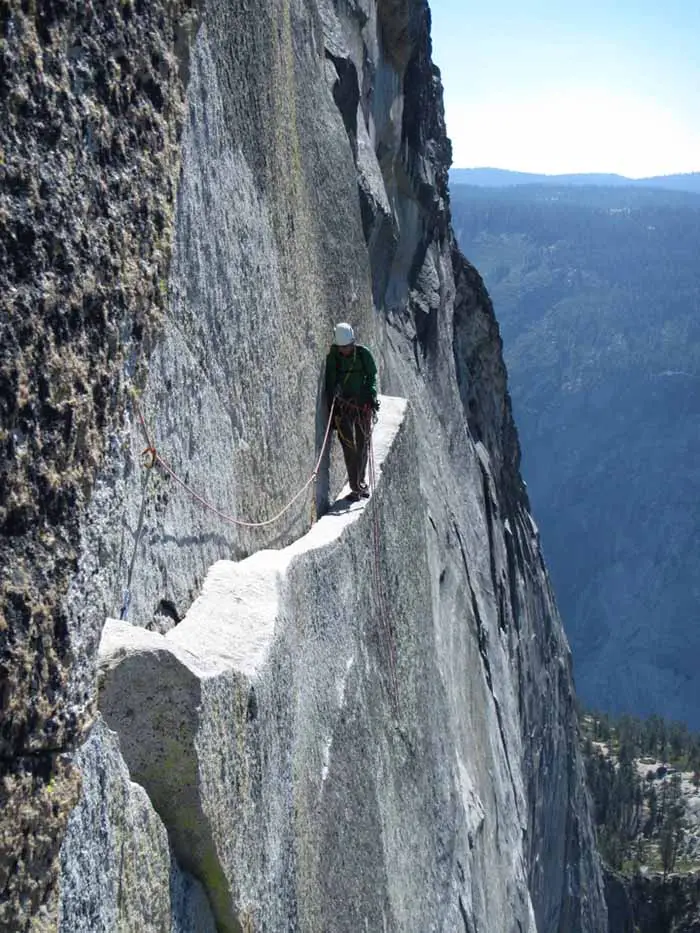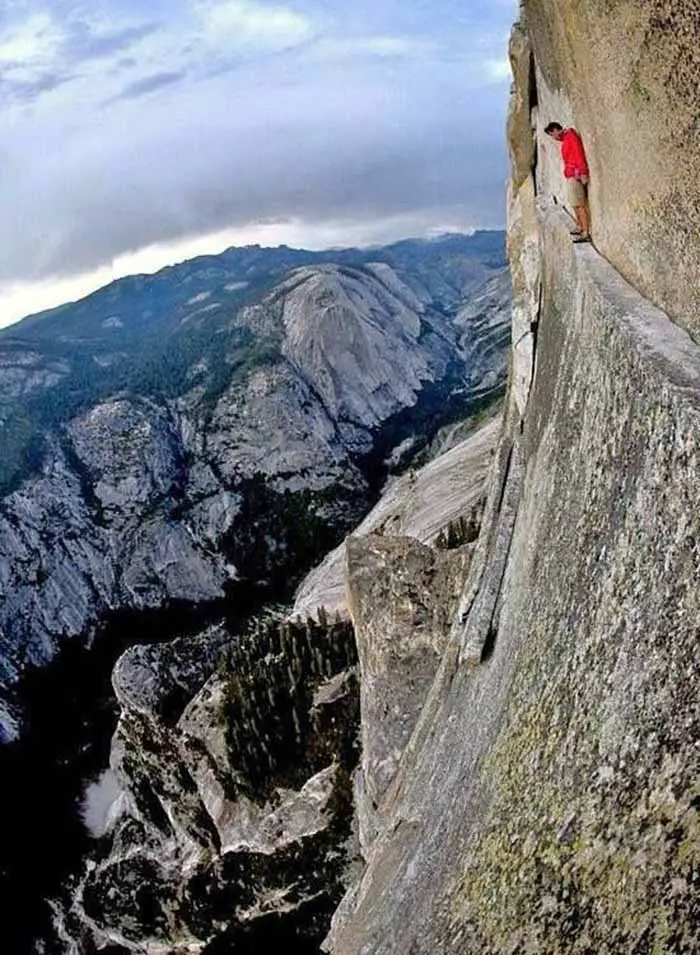
Ascent Log
| Climber | Suggested Grade | Date of Ascent | Notes |
|---|---|---|---|
| Royal Robbins, Mike Sherrick, Jerry Gallwas | 5.9 | 24th June 1957 | The first ascent of the once unattainable route. Robbins and Co spent 5 days on the wall. Article |
| Art Higbee, Jim Erickson | 5.12 | 1976 | This was the almost first free ascent. Higbee and Erickson used aid to get them up pitch 22, the hardest pitch on the route. Article |
| Alex Honnold | 5.12 | 6th Sep 2008 | First free solo and one of the hardest for Alex at the time. He panicked on pitch 22 and nearly grabbed a carabiner but he composed himself, trusted his feet and summited. Video |

Climb Profile
The Route
The Regular Northwest Face of Half Dome is a monumental Grade VI big wall climbing route, recognized as the first of its kind in the United States. Towering over the Yosemite Valley, this iconic granite face offers climbers a challenging ascent that has captivated the climbing community for decades.
The current aid climbing rating stands at VI 5.9 A1. For those attempting the free climbing variation, the route is graded at 5.12.
The Regular Northwest Face offers a diverse climbing experience, with the first eleven pitches primarily situated to the left of the rockfall line. The traverse on the 12th pitch takes climbers across the top of the roofs resulting from a significant rockfall in July 2015. The climb is characterized by steep corners, blank faces, and a series of ledges.
While most of the climbing is moderate, there are short cruxes that challenge even seasoned climbers. Notable sections include the “Thank God Ledge Traverse,” a psychological crux that leaves a lasting impression on those who dare to cross it, and a 5.8 squeeze after the traverse that many consider the technical crux.
The ascent spans a vertical distance of approximately 2,000 feet, making it a substantial endeavor for climbers. While the first ascent took five days, modern climbers often complete the route in two days, with some pushing for speed records.
The Regular Northwest Face of Half Dome holds a special place in climbing history. It’s featured in the historic climbing text “Fifty Classic Climbs of North America” and is revered as a classic worldwide. Over the years, the route has seen numerous ascents, each adding to its rich legacy. From the first free solo ascent by Alex Honnold in 2008 to the significant rockfall in 2015 that altered the route, the Regular Northwest Face continues to evolve and inspire climbers from around the world.
First Ascent (Aid)
24th June 1957: Royal Robbins, Mike Sherrick, Jerry Gallwas
The first serious attempt to ascend the Northwest Face of Half Dome was made in 1955 by Jerry Gallwas, Don Wilson, Royal Robbins, and Warren Harding. Despite their efforts, the team managed to climb only 500 feet over five days before retreating. However, the allure of the face remained, and in 1957, Gallwas and Robbins, now equipped with new chrome-molybdenum pitons crafted by Gallwas, teamed up with Mike Sherrick for another attempt.

Setting off on June 24, 1957, the trio was determined to complete the route. Over the next five days, they faced numerous challenges, from blank sections of rock that required hours of hand-drilling expansion bolts to thinning cracks that tested their climbing skills and resolve. Gallwas, leading a crucial pitch near the summit, found himself at an impasse with the overhanging brim just out of reach. Just when the situation seemed dire, Gallwas spotted a ledge, exclaiming, “A ledge! There’s a ledge! An amazing ledge.” This 35-foot ledge, later named the “Thank God Ledge,” provided the team with the means to bridge two pitches, making the established route possible.
The Thank God Ledge, while not the most comfortable or the largest ledge on the climb, became a symbol of hope and determination. Its narrow width and sloping nature often force climbers to crawl rather than walk, adding to its legendary status.

After five days of audacious climbing, Robbins, Gallwas, and Sherrick reached the summit, marking the first successful ascent of the Regular Northwest Face of Half Dome. Their achievement was not just a personal victory but a monumental leap forward in rock climbing. This ascent, the first Grade VI wall to be conquered in the United States, showcased the untapped potential of big-wall climbing in Yosemite and set the stage for future generations of climbers.
First Free Ascent (Almost)
1976: Art Higbee, Jim Erickson
In 1976, nineteen years after the first ascent made by Robins & Co, Colorado-based climbers Art Higbee and Jim Erickson made the almost first free ascent of the Northwest Face of Half Dome. This was Erickson’s 10th attempt to free Half Dome.

They spent 34 grueling hours roped together, belaying every pitch while using pitons, nuts and bolts for protection. I say the ‘almost’ free ascent as 100 ft from the summit Erickson and Higbee had to resort to aid to get through the final crux on pitch 22, which was a 5.12c section.
What Erickson and Higbee saw as a failure, others saw it as a success. They received praise from climbers around the world and were granted the first free ascent. They gave the route a 5.12 grade, which was the highest level of technical difficulty at the time.
First Free Solo
6th Sep 2008: Alex Honnold
Alex dwelled on Half Dome for a few months, and feeling in good shape, he decided it was time to attempt the route free solo. He had already freed the route around 6 times so he knew all the moves and cruxes.
There are three completely blank faces on the route which Robbins & Co used aid. Erickson and Higbee managed to find a way to bypass those sections and climbed them with rope and pros. Alex knows it’s possible to climb the route completely free, he’s done it before so there was no reason why he couldn’t do it free solo.

Armed with his Miura climbing shoes, chalk bag, a half-full bottle of water in one pocket and a Clif bar in the other, he stood at the bottom of the route and began the first pitch.
Alex cruised through the route until he got 100 ft from the top. This is the exact same slabby pitch, pitch 22, where Erickson and Higbee used aid to get them through it. A stone’s throw away from the summit, Alex could hear the laughter and chatter of hikers above. He was left in a precarious position, with his fingers and feet barely on anything. A carabiner dangled 2 inches above his right hand. Grabbing the carabiner crossed his mind. It would make the move easy and he would reach the jug, no problem.
But no, that wouldn’t have been the clean send he wanted. He stopped procrastinating, smeared his foot, stood up and grabbed the jug. The hardest part was over and after a few minutes, he stood on top of Yosemite Valley having just made the hardest ascent of his life.
Much to his disappointment, none of the tourists batted an eyelid on what just happened. Perhaps he just looked like a lost hiker, or no one understood what had just happened. Barefoot, he made his way back down the Half Dome cables having just made history as one of the best free solo climbers in the world.

Legacy
From the pioneering ascent by Robbins, Gallwas, and Sherrick in 1957 to the audacious free solo ascent of Alex Honnold, this iconic granite face has been the backdrop for some of climbing’s most defining moments.
Now, you’ll find climbers from all around the world making their way to climb the most iconic big wall route in the world.

Video Library




The Regular Route, Northwest Face of Half Dome was the first Grade VI in the world. You can see Jerry Gallwas’ hand forged pitons and other historic artifacts from Yosemite’s climbing history at the Yosemite Climbing Museum in Mariposa, CA. You can also see the original Stoveleg pitons and the John Salathe’s rope and rack.
This is a must visit place for anyone interested in Yosemite climbing.